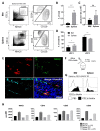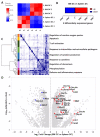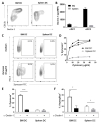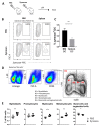Bone Marrow Harbors a Unique Population of Dendritic Cells with the Potential to Boost Neutrophil Formation upon Exposure to Fungal Antigen
- PMID: 35011617
- PMCID: PMC8750392
- DOI: 10.3390/cells11010055
Bone Marrow Harbors a Unique Population of Dendritic Cells with the Potential to Boost Neutrophil Formation upon Exposure to Fungal Antigen
Abstract
Apart from controlling hematopoiesis, the bone marrow (BM) also serves as a secondary lymphoid organ, as it can induce naïve T cell priming by resident dendritic cells (DC). When analyzing DCs in murine BM, we uncovered that they are localized around sinusoids, can (cross)-present antigens, become activated upon intravenous LPS-injection, and for the most part belong to the cDC2 subtype which is associated with Th2/Th17 immunity. Gene-expression profiling revealed that BM-resident DCs are enriched for several c-type lectins, including Dectin-1, which can bind beta-glucans expressed on fungi and yeast. Indeed, DCs in BM were much more efficient in phagocytosis of both yeast-derived zymosan-particles and Aspergillus conidiae than their splenic counterparts, which was highly dependent on Dectin-1. DCs in human BM could also phagocytose zymosan, which was dependent on β1-integrins. Moreover, zymosan-stimulated BM-resident DCs enhanced the differentiation of hematopoietic stem and progenitor cells towards neutrophils, while also boosting the maintenance of these progenitors. Our findings signify an important role for BM DCs as translators between infection and hematopoiesis, particularly in anti-fungal immunity. The ability of BM-resident DCs to boost neutrophil formation is relevant from a clinical perspective and contributes to our understanding of the increased susceptibility for fungal infections following BM damage.
Keywords: bone marrow; dectin-1; dendritic cells; fungal infection; granulopoiesis; hematopoiesis; zymosan.
Conflict of interest statement
The authors declare no conflict of interest.
Figures






Similar articles
-
An unappreciated role for neutrophil-DC hybrids in immunity to invasive fungal infections.PLoS Pathog. 2018 May 21;14(5):e1007073. doi: 10.1371/journal.ppat.1007073. eCollection 2018 May. PLoS Pathog. 2018. PMID: 29782541 Free PMC article.
-
Exploiting the role of endogenous lymphoid-resident dendritic cells in the priming of NKT cells and CD8+ T cells to dendritic cell-based vaccines.PLoS One. 2011 Mar 31;6(3):e17657. doi: 10.1371/journal.pone.0017657. PLoS One. 2011. PMID: 21483862 Free PMC article.
-
Dendritic cells support hematopoiesis of bone marrow cells.Transplantation. 2001 Sep 15;72(5):891-9. doi: 10.1097/00007890-200109150-00026. Transplantation. 2001. PMID: 11571456
-
Chemotactic response toward chemokines and its regulation by transforming growth factor-beta1 of murine bone marrow hematopoietic progenitor cell-derived different subset of dendritic cells.Blood. 1999 May 15;93(10):3225-32. Blood. 1999. PMID: 10233873
-
Systems biology of host-mycobiota interactions: dissecting Dectin-1 and Dectin-2 signalling in immune cells with DC-ATLAS.Immunobiology. 2013 Nov;218(11):1428-37. doi: 10.1016/j.imbio.2013.07.002. Epub 2013 Jul 13. Immunobiology. 2013. PMID: 23932568 Review.
Cited by
-
Code Red in the Supply Center: The Impact of Immune Activation on Hematopoiesis.Cells. 2022 May 9;11(9):1586. doi: 10.3390/cells11091586. Cells. 2022. PMID: 35563892 Free PMC article.
-
Canvassing Prospects of Glyco-Nanovaccines for Developing Cross-Presentation Mediated Anti-Tumor Immunotherapy.Vaccines (Basel). 2022 Nov 30;10(12):2049. doi: 10.3390/vaccines10122049. Vaccines (Basel). 2022. PMID: 36560459 Free PMC article. Review.
-
The role of immune cells settled in the bone marrow on adult hematopoietic stem cells.Cell Mol Life Sci. 2024 Oct 5;81(1):420. doi: 10.1007/s00018-024-05445-3. Cell Mol Life Sci. 2024. PMID: 39367881 Free PMC article. Review.
References
-
- Milo I., Sapoznikov A., Kalchenko V., Tal O., Krauthgamer R., Van Rooijen N., Dudziak D., Jung S., Shakhar G. Dynamic imaging reveals promiscuous crosspresentation of blood-borne antigens to naïve CD8+ T cells in the bone marrow. Blood. 2013;122:193–208. doi: 10.1182/blood-2012-01-401265. - DOI - PubMed
Publication types
MeSH terms
Substances
Grants and funding
LinkOut - more resources
Full Text Sources
Molecular Biology Databases
Miscellaneous

